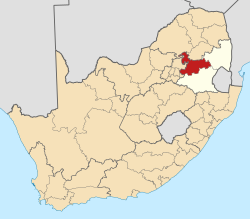Botshabelo | |
|---|---|
 Cultural heritage monument in Botshabelo | |
| Coordinates: 25°41′59″S29°24′35″E / 25.69972°S 29.40972°E | |
| Country | South Africa |
| Province | Mpumalanga |
| District | Nkangala |
| Municipality | Steve Tshwete |
| Time zone | UTC+2 (SAST) |
| Postal code (street) | 9781 |
| PO box | 9781 |
| Area code | 051 |
Botshabelo ("place of refuge" in the Northern Sotho language) in the district of Middelburg, in Mpumalanga Province, South Africa, originated as a mission station established by Alexander Merensky of the Berlin Missionary Society (BMS), in February 1865 in what was then the Transvaal Republic (ZAR). [1] [2] Merensky had fled with a small number of parishioners following the attacks on his previous mission station, Ga-Ratau, by the soldiers of Sekhukhune, the king of the baPedi. Within a year of having established the mission station, the population had grown to 420 persons. In 1873 Merensky was joined by BMS missionary Johannes Winter, who went on to found the mission station at Thaba Mosego and also played an instrumental role in the establishment of the Lutheran Bapedi Church, when they seceded from the BMS in 1889. [3]
Contents
- Anglo–Boer War
- Publications about Botshabelo Mission Station
- Ndebele architecture of Cultural Village
- Botshabelo, Middelburg
- Notable people
- References
- External links
The BMS focused on providing schooling and bringing the gospel to people in their own language. Hence the Society's missionaries were often at the forefront of publishing Bible translations, dictionaries and grammars in indigenous languages. It was as part of this process that Africans, duly trained and sometimes salaried, were accepted into the Society as teachers, catechists and lay-preachers, the so-called Nationalhelferen or national helpers. [4]
One of these was one Jan Sekoto who was sent for further training in Germany. Returning earlier than anticipated, however, he took up a teaching post at Botshabelo. Sekoto's son Gerard Sekoto, born at Botshabelo in 1913, [5] would later emigrate to Europe, obtaining French citizenship and achieving considerable renown as an artist. [6]
Besides the vestiges of the past, today Botshabelo is a living museum for the Ndebele architecture. Differing opinions on how to manage the site, combined with a lack of resources and expertise, have led to a gradual degradation of a very important historical site and tourist attraction. [7]








